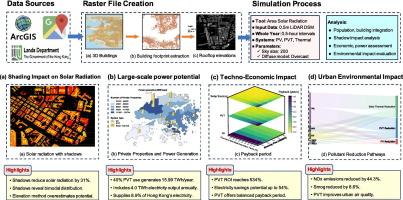高密度城市环境中光伏、光伏-热和太阳能热系统的大规模分析
IF 11
1区 工程技术
Q1 ENERGY & FUELS
引用次数: 0
摘要
城市太阳能在高密度环境中的部署通常受到屋顶可用性、建筑高度和遮阳的限制。本研究提出了一个强大的、数据驱动的框架,整合了高分辨率地理信息系统数据、3D建筑模型和详细的城市形态,以评估各种太阳能技术的潜力,包括标准光伏系统、光伏热(PVT)系统(例如,使用水、空气或制冷剂作为传热介质)和太阳能热系统(例如,平板或真空管集热器与水或空气)。以香港为例,分析强调了城市几何的影响,表明结合遮阳可以减少31%的屋顶太阳辐射。在评估的技术中,光伏-热系统显示出最高的综合能源产量,每年产生约15.99太瓦时(电和热),40%的屋顶利用率。其中,电力每年消耗4.0太瓦时,约占香港总用电量(2022年为44.8太瓦时)的8.9%,占最终能源使用量的33%。在住宅领域,冷却和热水各占能源需求的25 - 26%,强调热电联合输出的价值。热结果代表理论最大值,因为没有对建筑特定的热需求进行建模。这一部署可以抵消目前能源进口的30.8%,将NOₓ排放量降低44.3%,并将形成雾霾的污染物减少8.6%。拟议的框架为城市能源规划提供了一种可扩展、可转移的方法,使世界各地的城市能够更有效地利用屋顶太阳能,实现可持续性和气候适应性。本文章由计算机程序翻译,如有差异,请以英文原文为准。

Large-scale analysis of photovoltaic, photovoltaic-thermal, and solar thermal systems in high-density urban environments
Urban solar energy deployment in high-density environments is often limited by rooftop availability, building height, and shading. This study presents a robust, data-driven framework integrating high-resolution Geographic Information System data, 3D building models, and detailed urban morphology to evaluate the potential of various solar technologies, including standard photovoltaic systems, photovoltaic-thermal (PVT) systems (e.g., using water, air, or refrigerant as heat transfer media), and solar thermal systems (e.g., flat-plate or evacuated tube collectors with water or air). Using Hong Kong as a case study, the analysis highlights the impact of urban geometry, showing that incorporating shading reduces rooftop solar radiation by 31 %. Among the technologies assessed, photovoltaic-thermal systems demonstrate the highest combined energy yield, generating approximately 15.99 TWh per year (electricity and heat) from 40 % rooftop utilization. Of this, electricity accounts for 4.0 TWh/year—about 8.9 % of Hong Kong's total electricity consumption (44.8 TWh in 2022), which comprises 33 % of its final energy use. In the residential sector, cooling and hot water each account for 25–26 % of energy demand, emphasizing the value of combined thermal and electrical outputs. Thermal results represent theoretical maximums, as building-specific thermal demands were not modelled. This deployment could offset up to 30.8% of current energy imports, lower NOₓ emissions by 44.3%, and decrease smog-forming pollutants by 8.6%. The proposed framework offers a scalable, transferable approach to urban energy planning, enabling cities worldwide to harness rooftop solar energy more effectively for sustainability and climate resilience.
求助全文
通过发布文献求助,成功后即可免费获取论文全文。
去求助
来源期刊

Applied Energy
工程技术-工程:化工
CiteScore
21.20
自引率
10.70%
发文量
1830
审稿时长
41 days
期刊介绍:
Applied Energy serves as a platform for sharing innovations, research, development, and demonstrations in energy conversion, conservation, and sustainable energy systems. The journal covers topics such as optimal energy resource use, environmental pollutant mitigation, and energy process analysis. It welcomes original papers, review articles, technical notes, and letters to the editor. Authors are encouraged to submit manuscripts that bridge the gap between research, development, and implementation. The journal addresses a wide spectrum of topics, including fossil and renewable energy technologies, energy economics, and environmental impacts. Applied Energy also explores modeling and forecasting, conservation strategies, and the social and economic implications of energy policies, including climate change mitigation. It is complemented by the open-access journal Advances in Applied Energy.
 求助内容:
求助内容: 应助结果提醒方式:
应助结果提醒方式:


